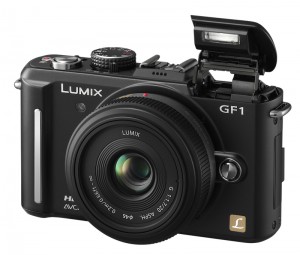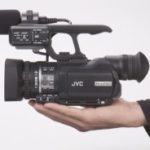
Mini Reviews – Nikon D300s / Kodak Zi8 / Panasonic DMC-GF1 / Books Review
Posted on Mar 29, 2010 by Alex Fice
The Nikon D300s – great stills camera but for video – Could Do Better!
NIKON D300S HDSLR
Seb Coe and Steve Ovett, Blur and Oasis, Federer and Nadal, Canon and Nikon. To be truly tested you need a worthy competitor and for years, in the stills market, these guys, N and C, have been knocking several bells out of each other to produce better and better stills cameras. But recently something has happened to upset the status quo, and that is video. Ever since Nikon introduced the ability to shoot video on their D90 model, it is Canon who has progressed with it more. That’s surprising because you would think that Canon, with their own camcorder division, would be the furthest from the potential to canabilise that market with even more new video gear. It is Nikon who hasn’t got a camcorder division to feast on!
Having said that Nikon are producing DSLR models with video and they are getting better with every launch. The D300s is an update of an existing camera the D300 but this time it has video, 24 fps at 720 in the progressive mode. But there is hardly any help for the serious videographer with the ‘S’ version apart from a button pressed autofocus which chugs away trying to sort out changes in contrast and isn’t really worth using.
The 300s has a cropped sensor which Nikon call the DX and records video at 24p with the MJPEG compression which is pretty old and inefficient nowadays but can still be easier to deal with than AVCHD and H.264 depending on how powerful your computer is.
The 300s is a terrific DSLR but with video as a definite option – but if you see the camera in that light you can start getting very nice results. The sensor isn’t full frame so you won’t get some of the miniscule depth of field from cameras like the Canon 5D MkII but it’s good enough but still hasn’t got the tonal beauty that has marked the MkII out for special praise.
Clever features that help the video are the dual card slots, SDHC and CF, both of which you can assign. One can be for stills and the other video for instance. There is also an external microphone input which is a first for Nikon DSLRs.
Nikon has since released their top of the range D3s with again no manual control over video, or so we thought. Since the launch the Blogosphere has found that you can manually control the video which Nikon didn’t seem to know. So where does this leave Nikon and their video? Well could do better but we still have high hopes for the future, especially as they haven’t got an existing video division to spoil.
KODAK Zi8 CAMCORDER
The term ‘form factor’ is a very dreary expression, especially as it describes something so important. ‘Touch and Feel’ factor is better, or ‘Human to Thing’ factor. It basically means how the design of the thing, in this case a personal camcorder, fits around you and your world. That’s why the Kodak Zi8 and the like are increasingly popular. They get used even though the video quality isn’t the best around.
Kodak’s Zi8 is one of a number of new ‘personal’ camcorders which is another way of saying a video device you hold in your hand like a mobile phone. It’s very simple to use with the minimum amount of buttons and a small menu. You can choose a Landscape or Macro setting and then your movie settings or your stills setting – stills are only 5MP.
People love these things and it has nothing to do with the video quality which isn’t good. It has everything to do with ease of use and the quickest way to get your content on to YouTube. The camcorder actually has software embedded in it that will upload the video to YouTube when you connect to a PC – this feature doesn’t work on Macs but iMovie is nearly as quick.
Features, on paper, are quite impressive – image stabilisation, digital zoom, stereo microphone jack, up to 1080p with 60 (Actually 59.94) frames a second at 720p. Hold the phone! 60fps! That’ll give you some slow motion then.
Well yes but you have to transcode your file to something more manageable from the ‘Ambarella’ AVC codec Kodak have chosen because all the NLE editors we have, apart from iMovie, don’t like it. We just transcoded to Apple Intermediate and then conformed through Cinema Tools to get half speed. But real, not invented, slow motion from a less than £150 camcorder isn’t a bad thing!
But I don’t want you thinking the video is anything you can use, unless you work on a very obscure digital channel! The smearing is awful and ‘jello-cam’ effect is truly wobbly especially at 1080p.
The Zi8 should be seen as a ready tool, something you can grab if you want some instant video. Behind the scenes maybe or some covert type footage or even a video diary tool.
 Panasonic’s GF1 – Small, sweet and a pocket rocket
Panasonic’s GF1 – Small, sweet and a pocket rocket
PANASONIC DMC-GF1
Does the Micro Four Thirds digital photography standard impact on us digital video users? When we reviewed ‘big brother’ the Panasonic GH1 we found an added benefit to the format for video users – extra stability. The format does away with the mirror box so when shooting video you can still use the EVF to look through (DSLRs shooting video have to have the mirror up which stops you looking through the viewfinder). Keeping the camera to the eye keeps the camera relatively steady without having to hold the camera at arm’s length to see what you’re shooting.
We liked the GH1, one of the first digital still cameras re-designed for video use (from it’s G1 origins). So along comes it’s little sibling and as product economics demand it is a de-tuned version. So you get what Panasonic has labelled AVCHD lite which is 720/25p not the full 1080p you get with the GH1, you get a similar ‘record’ button where everyone can see it but you don’t get the manual exposure for video the GH1 gets. You only get some help with the aperture using a software slider which goes from open to less open! No manual shutter or ISO control for video and no 50fps for slow motion.
The biggest omission is the EVF so negating that added stability feature, you can buy a detachable one to give you the stability of the ‘camera hug’ but at around £170 it’s easy not to bother.
The GF1 comes as a kit with either a 14-45mm f3.5 – 5.6 or the 20mm f1.7 pancake lens. The 20mm lens is a delight and very usable with HD Video aping that shallow depth of field that has all HD Users enraptured. There are other lenses within the format including a 7-14mm wide zoom but you can also investigate lens mount adapters for other lenses namely Leica (A Panasonic product probably due to their lens relationship with Leica). Check eBay for other adapters.
HD Video is available on all of the click-dial choices but it is on the movie mode you can use the depth of field slider. Continuous AF does work with video but is really quite slow and noisy so best switch to manual focus which has the enlarged pixel view to help with the focus – better implemented here than most video DSLRs.
In a way noisy AF doesn’t matter because the audio isn’t particularly good on this model due to that de-tuning from the GH1. You only get mono and no audio jack.
So where does that leave the GF1 for video use? With the video market expanding, especially online there is a definite use for this camera even with it’s poor audio. Use separate audio and the 20mm 1.7 lens and you can achieve some interesting shallow DOF content which doesn’t have that ‘electric’ Panansonic look which you either love, hate or put up with. The GF1’s size versus its performance is the key here, carry it everywhere and get video you wouldn’t expect from such a small form factor. Kits are around £600 or you can buy the body only for around £450.
BOOK REVIEWS
VIDEO PRODUCTION HANDBOOK
Now in its fourth edition, Millerson and Owen’s Video Production Handbook covers pretty much all the basics of programme making, from YouTube to TV. Scripting and preproduction planning are dealt with, though not in great detail – you could write a shelf of books on those subjects alone – but the chapters on the camera and its use are excellent and there is respectable coverage of sound recording, lighting and post-production. We particularly liked the pace of the book, the reader is introduced gently with no assumption of previous experience, but by the end of the book he or she will have assimilated a great deal of knowledge about the video production process. We also liked the use of photographs and illustrations to back up the written word. Definitely recommended for those starting out in the business or, for instance, a researcher making the step up to production.
BETTER LOCATION SHOOTING
If you are involved in any way with location shooting you should read Paul Martingell’s Better Location Shooting – even if you are pretty experienced you may not learn anything new, but you’ll be entertained none-the-less. Paul’s book covers a similar range of topics as the Video Production Handbook but is, as the title suggests, skewed towards location shooting. There is more assumption of some previous experience, so the book won’t suit the total beginner, but neither is it full of dry technical information. Chapters cover both camera and sound equipment and their use, lighting, interviews, news and current affairs, as well as shooting for the edit, health and safety and shooting abroad. Above all, though, it’s the way the book is written that is so engaging – Mr. Martingell writes in an informal and entertaining style, with plenty of (mostly self deprecating) personal stories.
BOTH TITLES PUBLISHED BY FOCAL PRESS













